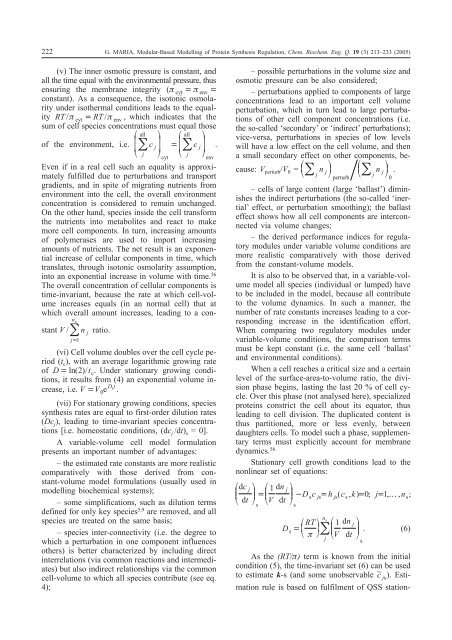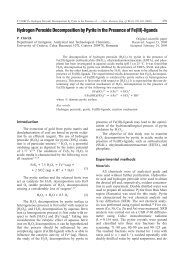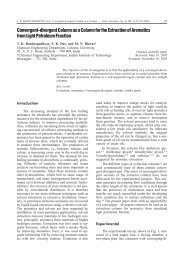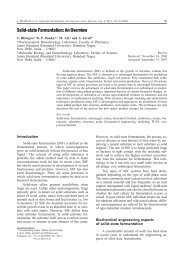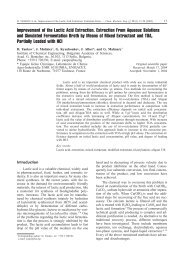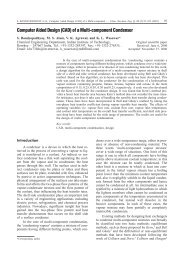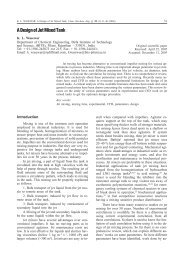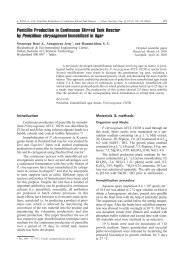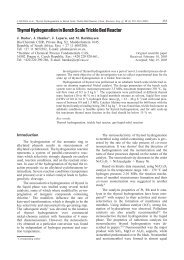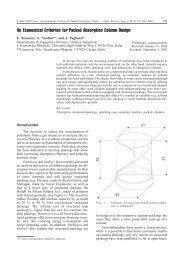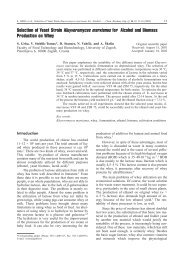Modular-Based Modelling of Protein Synthesis Regulation
Modular-Based Modelling of Protein Synthesis Regulation
Modular-Based Modelling of Protein Synthesis Regulation
You also want an ePaper? Increase the reach of your titles
YUMPU automatically turns print PDFs into web optimized ePapers that Google loves.
222 G. MARIA, <strong>Modular</strong>-<strong>Based</strong> <strong>Modelling</strong> <strong>of</strong> <strong>Protein</strong> <strong>Synthesis</strong> <strong>Regulation</strong>, Chem. Biochem. Eng. Q. 19 (3) 213–233 (2005)<br />
(v) The inner osmotic pressure is constant, and<br />
all the time equal with the environmental pressure, thus<br />
ensuring the membrane integrity (cyt<br />
env<br />
<br />
constant). As a consequence, the isotonic osmolarity<br />
under isothermal conditions leads to the equality<br />
RT / cyt<br />
RT / env<br />
, which indicates that the<br />
sum <strong>of</strong> cell species concentrations must equal those<br />
all all <br />
<br />
<strong>of</strong> the environment, i.e. c j <br />
c<br />
j .<br />
j j <br />
cyt<br />
env<br />
Even if in a real cell such an equality is approximately<br />
fulfilled due to perturbations and transport<br />
gradients, and in spite <strong>of</strong> migrating nutrients from<br />
environment into the cell, the overall environment<br />
concentration is considered to remain unchanged.<br />
On the other hand, species inside the cell transform<br />
the nutrients into metabolites and react to make<br />
more cell components. In turn, increasing amounts<br />
<strong>of</strong> polymerases are used to import increasing<br />
amounts <strong>of</strong> nutrients. The net result is an exponential<br />
increase <strong>of</strong> cellular components in time, which<br />
translates, through isotonic osmolarity assumption,<br />
into an exponential increase in volume with time. 56<br />
The overall concentration <strong>of</strong> cellular components is<br />
time-invariant, because the rate at which cell-volume<br />
increases equals (in an normal cell) that at<br />
which overall amount increases, leading to a constant<br />
V/<br />
ns<br />
n j<br />
j1<br />
ratio.<br />
(vi) Cell volume doubles over the cell cycle period<br />
(t c ), with an average logarithmic growing rate<br />
<strong>of</strong> D ln( 2)/ tc.<br />
Under stationary growing conditions,<br />
it results from (4) an exponential volume increase,<br />
i.e. V V Dt<br />
0 e s .<br />
(vii) For stationary growing conditions, species<br />
synthesis rates are equal to first-order dilution rates<br />
(Dc j ), leading to time-invariant species concentrations<br />
[i.e. homeostatic conditions, (dc j /dt) s = 0].<br />
A variable-volume cell model formulation<br />
presents an important number <strong>of</strong> advantages:<br />
– the estimated rate constants are more realistic<br />
comparatively with those derived from constant-volume<br />
model formulations (usually used in<br />
modelling biochemical systems);<br />
– some simplifications, such as dilution terms<br />
defined for only key species 5,9 are removed, and all<br />
species are treated on the same basis;<br />
– species inter-connectivity (i.e. the degree to<br />
which a perturbation in one component influences<br />
others) is better characterized by including direct<br />
interrelations (via common reactions and intermediates)<br />
but also indirect relationships via the common<br />
cell-volume to which all species contribute (see eq.<br />
4);<br />
– possible perturbations in the volume size and<br />
osmotic pressure can be also considered;<br />
– perturbations applied to components <strong>of</strong> large<br />
concentrations lead to an important cell volume<br />
perturbation, which in turn lead to large perturbations<br />
<strong>of</strong> other cell component concentrations (i.e.<br />
the so-called ‘secondary’ or ‘indirect’ perturbations);<br />
vice-versa, perturbations in species <strong>of</strong> low levels<br />
will have a low effect on the cell volume, and then<br />
a small secondary effect on other components, because:<br />
V perturb /V 0 = n <br />
<br />
j n <br />
j j<br />
j <br />
.<br />
perturb 0<br />
– cells <strong>of</strong> large content (large ‘ballast’) diminishes<br />
the indirect perturbations (the so-called ‘inertial’<br />
effect, or perturbation smoothing); the ballast<br />
effect shows how all cell components are interconnected<br />
via volume changes;<br />
– the derived performance indices for regulatory<br />
modules under variable volume conditions are<br />
more realistic comparatively with those derived<br />
from the constant-volume models.<br />
It is also to be observed that, in a variable-volume<br />
model all species (individual or lumped) have<br />
to be included in the model, because all contribute<br />
to the volume dynamics. In such a manner, the<br />
number <strong>of</strong> rate constants increases leading to a corresponding<br />
increase in the identification effort.<br />
When comparing two regulatory modules under<br />
variable-volume conditions, the comparison terms<br />
must be kept constant (i.e. the same cell ‘ballast’<br />
and environmental conditions).<br />
When a cell reaches a critical size and a certain<br />
level <strong>of</strong> the surface-area-to-volume ratio, the division<br />
phase begins, lasting the last 20 % <strong>of</strong> cell cycle.<br />
Over this phase (not analysed here), specialized<br />
proteins constrict the cell about its equator, thus<br />
leading to cell division. The duplicated content is<br />
thus partitioned, more or less evenly, between<br />
daughters cells. To model such a phase, supplementary<br />
terms must explicitly account for membrane<br />
dynamics. 56<br />
Stationary cell growth conditions lead to the<br />
nonlinear set <strong>of</strong> equations:<br />
dc<br />
<br />
dt<br />
j<br />
dn<br />
<br />
1<br />
<br />
V<br />
dt<br />
s<br />
j<br />
D<br />
<br />
<br />
Dc s jsh js( cs, k) 0; j<br />
1, , ns;<br />
<br />
s<br />
s<br />
RT<br />
<br />
<br />
<br />
n<br />
j<br />
dn<br />
1 j<br />
<br />
<br />
. (6)<br />
V<br />
dt<br />
<br />
s<br />
<br />
As the (RT/) term is known from the initial<br />
condition (5), the time-invariant set (6) can be used<br />
to estimate k-s (and some unobservable ~ c js ). Estimation<br />
rule is based on fulfilment <strong>of</strong> QSS station-<br />
s


